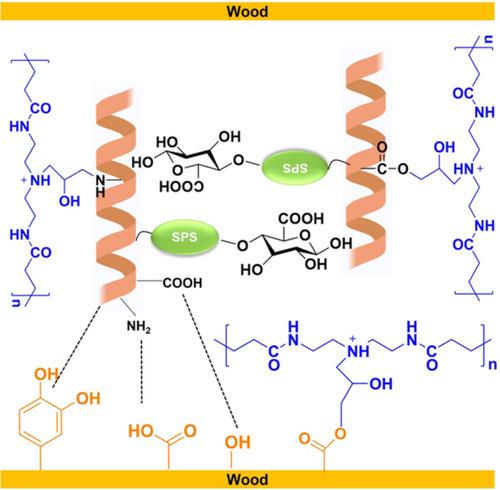当前位置:
X-MOL 学术
›
J. Appl. Polym. Sci.
›
论文详情
Our official English website, www.x-mol.net, welcomes your
feedback! (Note: you will need to create a separate account there.)
Controllable crosslinking system of soy protein-based adhesives via soybean polysaccharide for wood composites
Journal of Applied Polymer Science ( IF 2.7 ) Pub Date : 2022-09-29 , DOI: 10.1002/app.53161 Yan Mi 1 , Yumei Bai 1 , Daqian Gao 1 , Zhenhua Gao 1 , Hao Gu 1 , Weijun Yang 2
Journal of Applied Polymer Science ( IF 2.7 ) Pub Date : 2022-09-29 , DOI: 10.1002/app.53161 Yan Mi 1 , Yumei Bai 1 , Daqian Gao 1 , Zhenhua Gao 1 , Hao Gu 1 , Weijun Yang 2
Affiliation

|
The development of soy protein-based adhesives is an environment-friendly strategy to fabricate formaldehyde-free wood composite with desired properties. However, it remains challenge to effectively control crosslinking process and therefore tailor the property of soy protein-based adhesives. Herein, inspired by the components of defatted soy flour, a controllable crosslinking system of soy protein and epichlorohydrin-modified polyamidoamine was developed by adjusting the soybean polysaccharide contents. The results confirmed that soluble polysaccharide involved into the crosslinking system via Maillard reaction. Even though the weight ratios of polysaccharide in the adhesives increased from 0% to 60%, the water-insoluble contents of the cured adhesives were slightly driven down from 89.15% to 84.98%, meanwhile thermal stability of the cured adhesives can be improved 1.4 times. Moreover, polysaccharide can be used as a small molecular additive to reduce initial viscosity of the adhesive and achieve improved spread property and mechanical interlock with plywood. Notably, the soaked wet bond strength of the resultant plywood reached 1.58 MPa and the cycled wet bond strength reached 1.17 MPa, which meet the requirement of outdoor use, when the contents of polysaccharide in the adhesives were 40%. Therefore, this study may provide a facile and cost-effective approach to prepare a high-performance soy protein-based adhesive.
中文翻译:

大豆多糖大豆蛋白基粘合剂的可控交联体系用于木材复合材料
开发基于大豆蛋白的粘合剂是一种环境友好的策略,可以制造具有所需性能的无甲醛木材复合材料。然而,有效控制交联过程并因此调整大豆蛋白粘合剂的性能仍然是一个挑战。在此,受脱脂大豆粉成分的启发,通过调节大豆多糖含量,开发了一种大豆蛋白与环氧氯丙烷改性聚酰胺胺的可控交联体系。结果证实可溶性多糖通过美拉德反应参与到交联体系中。即使胶粘剂中多糖的重量比从 0% 增加到 60%,固化胶粘剂的水不溶性含量从 89.15% 略微下降到 84.98%,同时固化后胶粘剂的热稳定性可提高1.4倍。此外,多糖可用作小分子添加剂,以降低胶粘剂的初始粘度,提高铺展性和与胶合板的机械互锁性。值得注意的是,当胶粘剂中多糖含量为40%时,所得胶合板的浸泡湿粘结强度达到1.58 MPa,循环湿粘结强度达到1.17 MPa,满足户外使用要求。因此,本研究可能为制备高性能大豆蛋白粘合剂提供一种简便且具有成本效益的方法。当胶粘剂中多糖含量为40%时,所得胶合板的浸泡湿粘结强度达到1.58 MPa,循环湿粘结强度达到1.17 MPa,满足户外使用的要求。因此,本研究可能为制备高性能大豆蛋白粘合剂提供一种简便且具有成本效益的方法。当胶粘剂中多糖含量为40%时,所得胶合板的浸泡湿粘结强度达到1.58 MPa,循环湿粘结强度达到1.17 MPa,满足户外使用的要求。因此,本研究可能为制备高性能大豆蛋白粘合剂提供一种简便且具有成本效益的方法。
更新日期:2022-09-29
中文翻译:

大豆多糖大豆蛋白基粘合剂的可控交联体系用于木材复合材料
开发基于大豆蛋白的粘合剂是一种环境友好的策略,可以制造具有所需性能的无甲醛木材复合材料。然而,有效控制交联过程并因此调整大豆蛋白粘合剂的性能仍然是一个挑战。在此,受脱脂大豆粉成分的启发,通过调节大豆多糖含量,开发了一种大豆蛋白与环氧氯丙烷改性聚酰胺胺的可控交联体系。结果证实可溶性多糖通过美拉德反应参与到交联体系中。即使胶粘剂中多糖的重量比从 0% 增加到 60%,固化胶粘剂的水不溶性含量从 89.15% 略微下降到 84.98%,同时固化后胶粘剂的热稳定性可提高1.4倍。此外,多糖可用作小分子添加剂,以降低胶粘剂的初始粘度,提高铺展性和与胶合板的机械互锁性。值得注意的是,当胶粘剂中多糖含量为40%时,所得胶合板的浸泡湿粘结强度达到1.58 MPa,循环湿粘结强度达到1.17 MPa,满足户外使用要求。因此,本研究可能为制备高性能大豆蛋白粘合剂提供一种简便且具有成本效益的方法。当胶粘剂中多糖含量为40%时,所得胶合板的浸泡湿粘结强度达到1.58 MPa,循环湿粘结强度达到1.17 MPa,满足户外使用的要求。因此,本研究可能为制备高性能大豆蛋白粘合剂提供一种简便且具有成本效益的方法。当胶粘剂中多糖含量为40%时,所得胶合板的浸泡湿粘结强度达到1.58 MPa,循环湿粘结强度达到1.17 MPa,满足户外使用的要求。因此,本研究可能为制备高性能大豆蛋白粘合剂提供一种简便且具有成本效益的方法。


















































 京公网安备 11010802027423号
京公网安备 11010802027423号